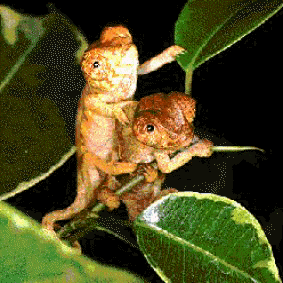|
The
Tongue
The
tongue is not bífida, as in the majority of the
lizards, but adopts the form of a catapult,
very gross in the extreme, and can be projected with
enormous rapidity to a distance over the length
of the head and the trunk of the animal juntos once
trapped and adhered the prey to the tip of the tongue,
this disappears with the same rapidity in the interior
Of the mouth. Said mechanism expands largely the
Food capture action field. The size of
the prey depends on the dimensions of the own one
camaleón: the small and medium hunt
mainly insects; the large capture also
Other lizards, small mamíferos and fowls. The
bone lingual is well developed in all they and
it performs an important paper in the mechanism of projection of the tongue. In the position of rest,
this, very musculada, is found rolled in around al bone. Before to be projected, the muscles
you circulate situated in its subsequent extreme itself
they contract violently
accumulating it
It further possible of the sharp extreme of the bone. Without
embargo, this operation only is possible when the
muscles longitudinales are relaxed, moment in
that they lose every efficacy in their paper of oponentes of
You circulate them. As this relaxation is produced
in a sudden way, the tongue itself unlike out of the
mouth under the effects of the resultant pressure; something
as well as if one it projected a seed of naranja
Pressing it with the tips of the fingers.
Follow, thanks to the elasticity of the weave and to
a new contraction of the muscles longitudinals, the tongue returns al point of departure
with the prey adhered her.
The
Extremities
The
extremities of the camleón, long and thin, they maintain
the body to certain height. The fingers of each foot itself
unite in two groups separated: two outsides and three
interior in the previous extremities; three exterior and two interiors in the subsequent. It
it does of the feet a species of tenacious that they permit al
Animal to be grasped firmly to the branches. By
addition,
the species of the kind Chameleon count on a queue
prensil, capable including of bearing for itself alone the weight
of the body.
Mimicry
and Temperament
Is
well acquaintance the capacity of the camaleón to change of
color, though the not specialists are done with
Frequency an idea very exaggerated of her. With all, the
physiological change of color is a very notorious process and
quick in the majority of the camaleones. What not
means that always they be able mimetizarse with what
It surrounds them. During the day, the corporeal coloring of
the arborícolas active constitutes a good protection;
for example the green one or the color bark, according to the
Medium. Very often, however, the coloring and the you stain they play a specific role in the disputes
among individuals of the same species. Some times only
They reflect a specific physiological state. A
important number of camaleones they acquire during the
dream a pale coloring, blancuzca, that, as a
luminous appliance, permits to discover them easily
among the dark one ramaje where during the day its color
It would protect them perfectly. The male, and to times the
females, they dominate a territory, that defend jealously against other individuals. But only in rare
occasions true fight is produced, although the horns
and crests of some
species would constitute probably some very effective elements of battle. When two rival they are found to
the distance of the view, they are threatened mutually
doing ostentation of their brilliant colors and,
inflating the body, they expose it of side al enemy
So that their aspect be more more impressive. Some
characteristic movements oscilatorios underline the
attitude of challenge, and some times their mouth is opened of
pair in pair to show the coloring contrastante of
The membrana mucosa. In
liberty, this psychological war suffices normally
So that one of the oponentes choose for being retired. Only
in them limited conditions of the captivity occur
authentic fights, and the bite they can inflict
Serious injuries and, to times, including to kill al rival. The
male defeated leaves constancy of its submission
singiness with the colors of a female or of a youth and retires
slowly. The victorious one leaves it to go, without the smaller opposition:
by the change of color is evident that have left of to offer interest as adversary.
 
In Danger
Proper
to its strange aspect and to its interesting biology, the
Chameleons they are favorite attraction in the terrarios.
But the consequences of the captivity are not very
Alentadoras. Generally, and still in the case that
since a principle they accept the food, they die to the
few months. These conditions of life and of breeding only
they are admitted of occasional way by some that another
exemplary of specific species. One of the many
reasons of this incompatibility resides in the strict one
I distribute of territories, that does impossible to put to a
male inside the visual radio from another of the same one
species. The majority they put eggs that the female
it places in pits excavated previsoramente by her
Same. The assembly of the operation encloses, for the
Camaleón arborícola, a great danger. Some
species, above all in the climate subtropical of Africa
southern and in zones of greater altitud, they have themselves
become viviparous. You raise them, completely
developed, they are born inside the membrana of the egg; themselves
they free of this so they are born and they begin their life
Independent. Not they need the guide of the parents for
To be become expert hunters.
|